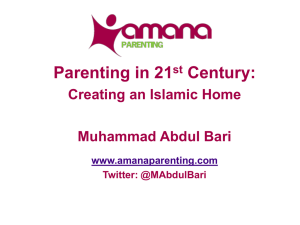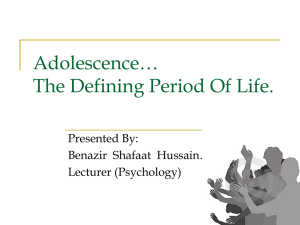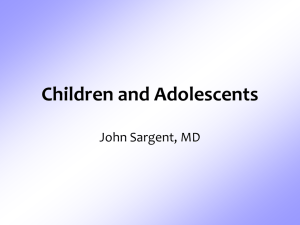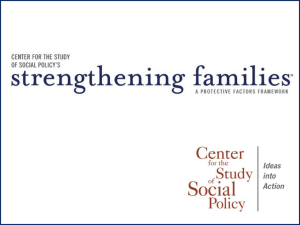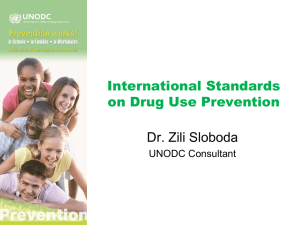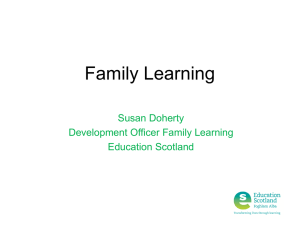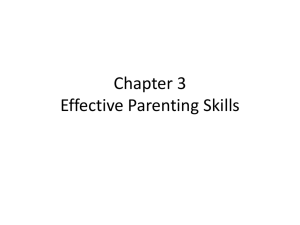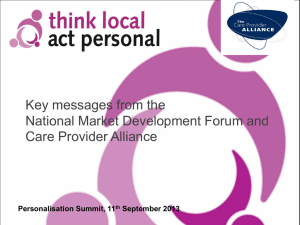PHE Starting Well Presentation August
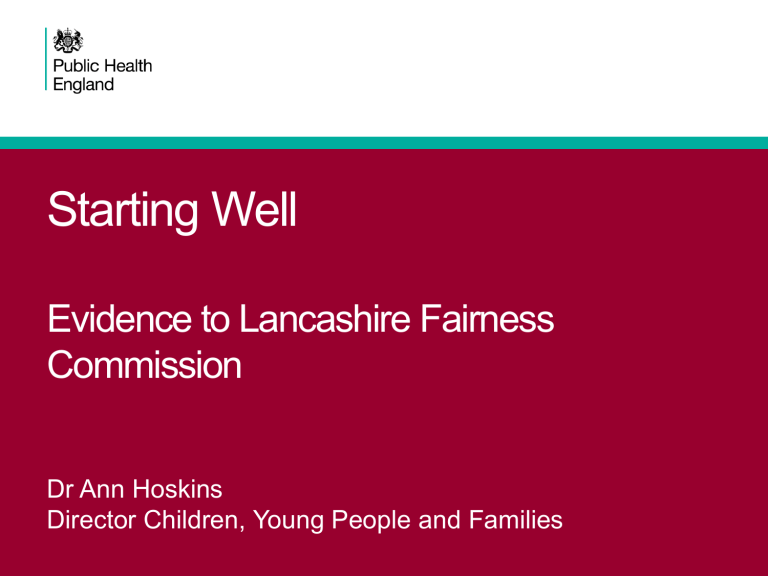
Starting Well
Evidence to Lancashire Fairness
Commission
Dr Ann Hoskins
Director Children, Young People and Families
2
UK’s u15s mortality is now amongst the worst in Europe
Since 1980 UK child mortality rate has moved from one of the best in 11
European countries to the worst.
3
Overview of issues to be covered
• Laying the foundations for good parenting including a healthy pregnancy
• Early years development that supports children from 0-5 and their families build their skills and resilience so that they are ready for school
• Support to teenagers and adolescents to build life skills and personal resilience to prepare them for the transition to adult life
4
Giving Every Child the Best Start in Life is crucial to reducing Health Inequalities across the life course
Ensure high quality maternity services, parenting programmes, childcare and early years education to meet need across the social gradient
Ensuring that parents have access to support during pregnancy is particularly important
An integrated policy framework is needed for early child development to include policies relating to the prenatal period and infancy, leading to the planning and commissioning of maternity, infant and early years family support services as part of a wider multi-agency approach to commissioning children and family services
5
Children, Young People and
Families: Life course approach
Marmot 2010, Fair Society, Healthy Lives: The Marmot Review
6
Why Children and Young People are a Priority
• The evidence base shows we can make a difference through early intervention and public health approaches
(http://www.dwp.gov.uk/docs/early-interventionnext-steps.pdf and www.earlyinterventionfoundation.org.uk
• There are economic and social arguments for investing in childhood. The
Family Nurse Partnership estimated savings five times greater than the cost of the programme in the form of reduced welfare and criminal justice expenditures; higher tax revenues and improved physical and mental health
(Department for Children, Schools and Families (2007) Cost –Benefit Analysis of Interventions with Parents.
Research Report DCSF-RW008)..
• Marmot showed that of c. 700,000 children born in 2010, if policies could be implemented to eradicate health inequalities, then each child could expect to live two years longer.
(http://www.instituteofhealthequity.org/projects/fair-society-healthy-lives-themarmot-review)
• Child poverty has short, medium and long term consequences for individuals, families, neighbourhoods, society and the economy. These consequences relate to health, education, employment, behaviour, finance, relationships and subjective well-being
(http://www.jrf.org.uk/system/files/2301-child-povertycosts.pdf.).
7
Environment matters for short, medium and long term outcomes
Inequality in early cognitive development of children in the 1970 British
Cohort Study, at ages 22 months to 10 years
8
Environment matters for short, medium and long term outcomes
Blackburn with Darwen Adverse Childhood Experiences:
Increased risk of having health behaviours/conditions in adulthood for individuals who experienced four or more ACE
STIs: risk is increased 30-fold
Heroin or Crack user: risk is increased 10-fold
Prison or cells: risk is increased 9-fold
Hit someone last 12 months: risk is increased 8-fold
Morbidly Obese : risk is increased 7-fold
Been hit in last 12 month: risk is increased 5-fold
Pregnant or got someone accidently pregnant under 18: risk is increased 4-fold
Regular heavy drinker: risk is increased 4-fold
Liver or digestive disease: risk is increased 2-fold
Adverse childhood experience;retrospective study to determine their impact on adult health behaviours and health outcomes in a
UK population. Bellis M,Lowey H, Leckenby N, Hughes K, Harrison D Journal of PH, advance access 013/04/14
Early years
10
Key factors for poor development outcomes
• Parental depression
*
• Parental illness or disability
• Smoking in pregnancy
*
• Parent at risk of alcoholism
• Domestic violence
• Parental worklessness
• Teenage mother
• Parental lack of basic skills, which limits daily activities
• Household overcrowding
• Financial stress
*
Teenage mother, smoking in pregnancy and parental depression frequently occur together
*
Associated with worst outcomes – cognitive emotional, conduct, hyperactivity, peer & pro-social Analysis of MCS, Sabates & Dex, 2013
11
The Scientific Base
Protective factors
• Breast feeding and nutrition
Bernardo LH, Rajiv B, Jose Cm, Cesar GV (2007) Evidence on the longterm effects of breastfeeding. Systematic reviews and meta-analysis, Geneva, WHO
• Immunization
NICE (2009) reducing the differences in the uptake of immunizations (including targeted vaccines) among children and young people under 19 , NICE PH guidance 21 London : NICE
• Parenting and parent–child relationship
Gardner FEM (1987) Positive interaction between mothers and children with conduct problems: is there training for harmony as well as fighting? Journal of Abnormal Child 15, 283- 93
Psychology
• Relationship between parents
Coleman L, Glenn F (2009) When couples part, Understanding the consequences for adults and children London: One plus One
Opportunities for LAs with transfer commissioning 0-5 years
Healthy Child Programme
Opportunities
• Joining up commissioning in local authorities for children’s public health, early years and wider family services
• Involving HWB to promote aligned/joint commissioning between LA, CCGs
(which commission NHS children services) for services around the child and family
• Streamlining universal access to Healthy Child Programme with early intervention and targeted interventions/programmes for families needing more help
• Joining up 0 – 5 Healthy Child Programme with 5 – 19 Healthy Child
Programme (which is already commissioned by LAs)
• Better integration of services at point of delivery with improved access and experience
Improved outcomes for children families and communities and reduced inequalities
Commissioning HCP 0-5
13
Progressive universalism
Universal plus
Additional parenting support e.g. sleep, feeding, behaviour
Universal
Core universal offer
Universal partnership plus e.g. Interagency work to support children in need
Child protection & safeguarding
Healthy Child Programme (HCP): best start for all children and extra help where needed
Universal
Health and development reviews
Screening and physical exam.
Immunisations
Promotion of health and wellbeing, e.g.: smoking, diet and physical activity, breastfeeding and healthy weaning, keeping safe, prevention of sudden infant death, maintaining infant health, dental health
Promotion of sensitive parenting and child development
Involvement of fathers
Mental health needs assessed
Preparation and support with transition to parenthood and family relationships
Signposting to information and services
Universal plus
Emotional and psychological problems addressed
Promotion and extra support with breastfeeding
Support with behaviour change
(smoking, diet, keeping safe,
SIDS, dental health)
Parenting support programmes, including assessment and promotion of parent – baby interaction
Promoting child development, including language
Additional support and monitoring for infants with health or developmental problems
Common Assessment
Framework completed
Higher risk
High-intensity-based intervention
Intensive structured home visiting programmes by skilled practitioners
Referral for specialist input
Action to safeguard the child
Contribution to care package led by specialist service
Common Assessment
Framework completed
SAFEGUARDING
15
Maternity and Early years: targeted interventions
• Targeted interventions by HV e.g. postnatal depression
• Working with the Troubled Families Programme to develop a health offer and improve integration with health services
• Family Nurse Partnership quality assurance of FNP unit
• Working with partners to promote early intervention including the Early
Intervention Foundation / Big Lottery
Every child ready to learn
To prevent early adversities stopping our children developing their full potential
694,241new opportunities available last year in the England
(ONS 2012)
Adolescence
18
Adolescence – periods of change
Adolescence and early adulthood represent a transition period marked by many pressures and challenges . . .
Physical and emotional changes . . .
Changing social relationships and growing academic and professional expectations
EuroHealthNet, Making the Link: Youth and Health Equity
19
Why focus on adolescence?
• There are more than 11.5 million aged 10-24 in England
• The rate of developmental change during adolescence is second only to infancy
• Good health allows young people to make the most of their teenage years – education and socialisation
• Many poor health outcomes for adults originate when we are young, for example smoking, mental health, obesity and violence
Behaviour across Adolescence
20
Source: Hawkins & Monahan 2009
21
Research from the CMO’s report
• All cause mortality for 10-19 year olds is now higher than for other periods of childhood except for newborns – main cause is Injury
• Five of the ten riskiest factors for the total burden of disease in adults are initiated or shaped in adolescence
• Adolescents have higher use of health services than other child categories above the age of 3
• There appears to be a window of vulnerability to risky behaviours between 14-17 years
22
PHE next steps
Adolescent health and wellbeing framework
A high level document to inform local strategies that will draw on what works and what matters
Working in collaboration with schools, FE and Local Authorities
Central to our work to support local improvements
– identifying what works from the evidence base, supporting evidence into practice
Strengthening the public health workforce
Wider than just ‘public health’ trained workforce – youth services, children’s centres, VCS etc
Foundations in adolescence and young adulthood
Our framework will be promoting:
• Using the 10-24 years life course period in line with CMO and WHO
• Raising importance of relationships, especially with parents/carers as well as peers
• Building life skills alongside raising awareness of key issues, such as sexual health, drugs and alcohol, positive mental health – and the importance of schools, colleges and other settings
• Building resilience – risk taking is an important part of development, how can young people be supported to make safe decisions
• Role of integrated or connected services – minimise the complexity of accessing services and maximise how they overlap
23 Challenges and opportunities for achieving public health outcomes for children and young people
How can we make a difference?
• Use knowledge about risk and what builds resilience
• Promote evidence and learning from practice about what works
• Combine targeted help for those most at risk with universal interventions
• Take a life course and place-based approach –early years, schools, families, and communities
• Work in partnership, taking a coordinated and collaborative approach, recognising strengths of different partners and using resources effectively
• Listen and act on what children, young people and parents/carers tell us
24 Challenges and opportunities for achieving public health outcomes for children and young people
